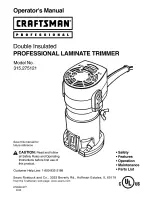
GB
| Operating Instructions
GB-5
not worn
• Inhalation of cut materials
Before use
Assembly of the protection shield
(Fig. 2)
Slide the included protection shield (3) over the blade rail
and fix it from both sides at the housing using 2 screws
on each side as shown in Fig. 2.
Power connection
The machine can only be connected to a single-phase
a.c. current connection. The machine is protectively in-
sulated in accordance with classification II of VDE 0740.
Before using the machine ensure that the mains current
agrees with the operating voltage data on the machine’s
identification plate.
Power Circuit Breaker:
Machines which will be used in different outside loca
-
tions must be connected to a Power Circuit Breaker.
Securing the power supply cable
(Fig. 3)
Only use cables (extension flex) that are approved for
outdoor use. The cable diameter must be equal to or bigger
than 1.5mm² for cable lengths up to 75m.
Put the coupling of the extension flex onto the shears‘
plug. For strain relief, stick a loop of the extension flex
through the opening in the handle and put it onto the
strain relief hook.
Extension flexes with a length of more than 30m reduce
the machine’s output.
Instructions for use of the equipment
Do not use the trimmer in rain or for cutting wet
hedges!
Check the hedge trimmer flex and its connections be
-
fore each and every use for visible signs of damage
(disconnect the power plug)! Do not use a faulty flex.
Gloves:
Protective gloves must be worn when using the
hedge trimmer.
Switching the hedge shears on/off
(Fig. 4)
When switching the hedge shears on take a safe stand.
These hedge shears have a two-hand safety switch. To
switch the hedge shears on the bar switch in the handle
(A) and the grip switch of the bow-type handle (B) must
be pushed down.
To switch the device off let go of both
switches. The motor already stops if one of the two
switches is released.
The breaking mechanism causes the blade to stop within
0.5 sec. The sparks (flashes) developing from this in the
area of the upper ventilation slots are normal and harm-
less for the device.
Adjusting the turning handle
(Fig. 5)
To facilitate your work the hedgetrimmer are equipped
with a turning rear handle that can be set in 5 different
positions [ right (45°/90°), left (45°/90°) and normal ]. The
purpose of this mechanism is that especially for cutting
in vertical direction the hedge shears can be held in their
ergonomically most favourable position whereby an early
fatigue of the user is avoided.
Please proceed as follows to change the position of the
handle:
Release switch (A). Press the locking pin (C). The handle
is now unlocked and can be turned to the desired posi-
tion. In the desired end position, the pin locks back into
place and securing the handle and avoiding an accidental
change of the position.
Please bear in mind that the locking pin (C) can only be
pulled back when the switch (A) is not activated (held
down). Make sure that the locking pin locks into place
again after repositioning the turning handle. Only then the
switch can be activated anew.
Maintenance
Always disconnect the plug from the power socket
before commencing any work on the machine.
Important: Always clean and oil the blades after pro-
longed use of the hedge trimmer. This will greatly affect
the life of the equipment. Damaged cutting units must be
properly repaired immediately. Clean the shearing blades
with a dry cloth or – in case of heavier dirt – with a brush.
Attention: Danger of injury!
Oiling of the blades should
ideally be carried out using an environmentally friendly
lubricant (Fig. 9).
Sharpening of the blades
The blades generally do not need servicing and do not
require resharpening if used correctly.
Changing the blades
Only correct installation of the blades will guarantee
problem-free operation and function of the above men-
tioned safety feature of the blades. Changing of the
blades should therefore only be carried out at a specialist
workshop.
Holding the hedge trimmer when in use
(Fig. 6+7)
This equipment will enable you to cut or trim bushes and
hedges easily and comfortably.
Trimming of hedges
- Young shoots are best cut in a scythe movement.
- Older and stronger hedges are best cut in a sawing
movement.
- Branches, which are too thick for the hedge trimmer,
should be cut with a saw.
- Sides of hedges should be cut upwards in a taper.
In order to achieve an even height
- Fix a guide line at the required height.
Summary of Contents for HS 6521
Page 3: ...A B 3 2 3 4 5 C...
Page 4: ...7 8 4 9 8 mm 6...
















































